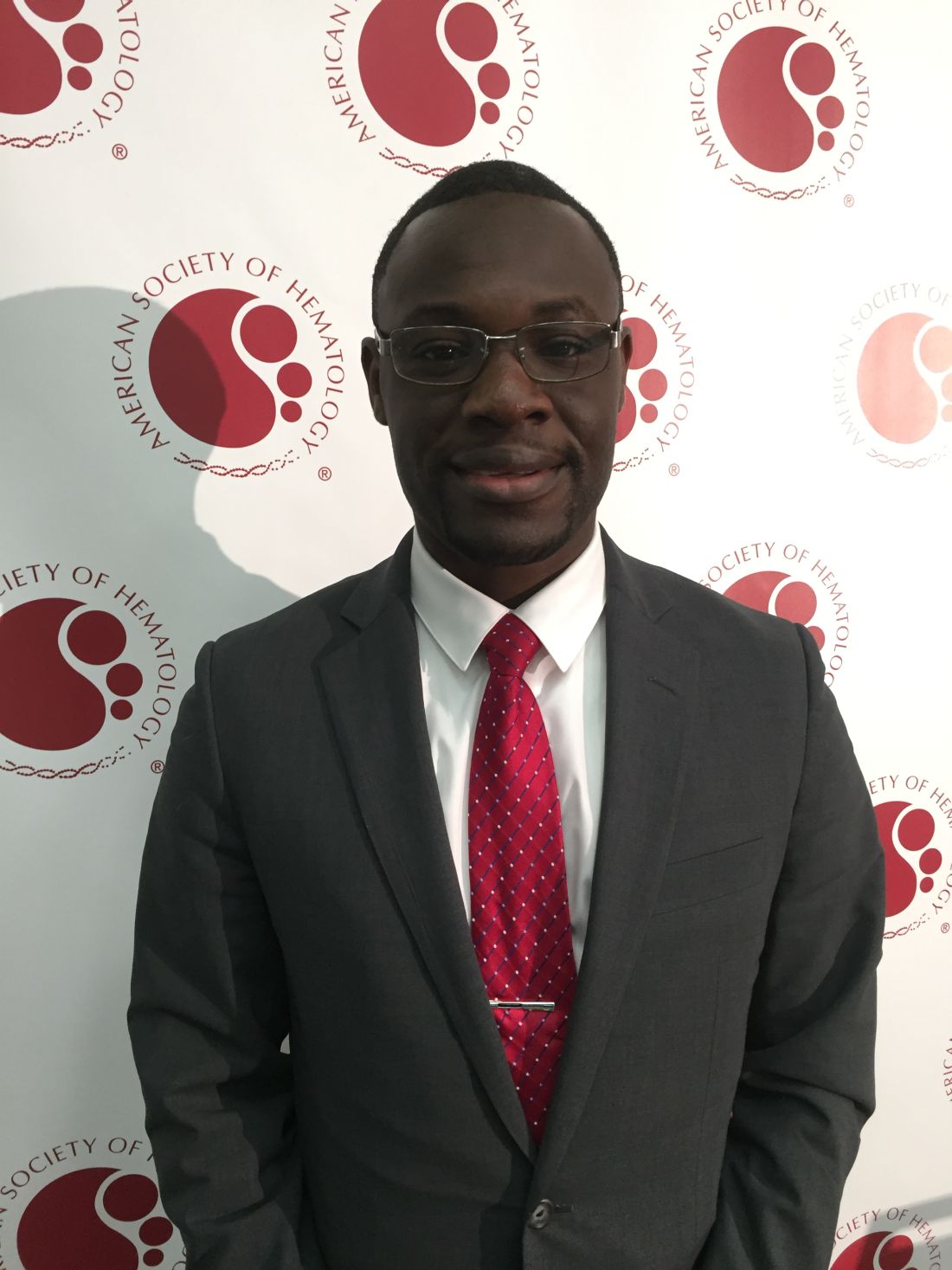User login
SAN DIEGO – Inpatient deaths from opioid overdose in the U.S. population has risen dramatically in recent years, but this is essentially a “never event” among patients with sickle cell disease (SCD).
These findings come from an analysis of hospital discharge data in the National Inpatient Sample from 1998 to 2013. Oladimeji Akinola Akinboro, MBBS, who led the study, said the findings suggest that the current patterns of opioid use in SCD patients are safe and that opioids should not be withheld when they are appropriate.
From 1998 to 2013, the rate of inpatient deaths from opioid overdose in the United States rose 350% overall and approximately 8% annually. In contrast, deaths among SCD patients were flat, with a rate at or near zero throughout the same time period.
Over the 16-year period, there were just nine deaths reported among SCD patients because of opioids in the inpatient setting, Dr. Akinboro of Boston University Medical Center reported at the annual meeting of the American Society of Hematology.
While the reasons behind the difference were not explored in the study, Dr. Akinboro suggested that the sickle cell community has greater experience with opioids and that patients and physicians typically have long-standing clinical relationships that make mitigation of opioid misuse easier to manage.
Opioid-related hospitalizations, however, were comparable among the general U.S. population and SCD patients. And for both groups the rates remained relatively steady throughout the study period, with the exception of a drop among SCD patients in 2002, he noted.
The study also revealed age-related trends in hospitalizations overall. Hospitalizations among sickle cell patients were stable from 1998 to 2013. However, when the researchers broke the data down by age they found that adults aged 18-44 years had an increase in hospitalizations, with the steepest rise in patients aged 65 years and older.
In total, there were more than 1.7 million hospitalizations among SCD patients in the United States from 1998 to 2013. The rate declined by 9.9% each year from 1998 to 2002, then remained flat at around 27 per 100,000 persons from 2002 to 2013.
However, for adults aged 18-44 years, hospitalizations increased from 43 per 100,000 persons in 2002 to 71 per 100,000 persons in 2013 – an annual increase of 3.8%. Patients aged 65 years and older saw their rate of hospitalization increase from 2.7 to 5.4 per 100,000 persons from 1998 to 2013 – a 6.5% increase for each year.
The study did not explore the causes behind the age-related trends but Dr. Akinboro suggested it may be because of fragmentation of adult SCD care and age- and pain-related medical comorbidities.
The researchers reported having no relevant financial disclosures.
SOURCE: Akinboro OA et al. ASH 2018, Abstract 315.
SAN DIEGO – Inpatient deaths from opioid overdose in the U.S. population has risen dramatically in recent years, but this is essentially a “never event” among patients with sickle cell disease (SCD).
These findings come from an analysis of hospital discharge data in the National Inpatient Sample from 1998 to 2013. Oladimeji Akinola Akinboro, MBBS, who led the study, said the findings suggest that the current patterns of opioid use in SCD patients are safe and that opioids should not be withheld when they are appropriate.
From 1998 to 2013, the rate of inpatient deaths from opioid overdose in the United States rose 350% overall and approximately 8% annually. In contrast, deaths among SCD patients were flat, with a rate at or near zero throughout the same time period.
Over the 16-year period, there were just nine deaths reported among SCD patients because of opioids in the inpatient setting, Dr. Akinboro of Boston University Medical Center reported at the annual meeting of the American Society of Hematology.
While the reasons behind the difference were not explored in the study, Dr. Akinboro suggested that the sickle cell community has greater experience with opioids and that patients and physicians typically have long-standing clinical relationships that make mitigation of opioid misuse easier to manage.
Opioid-related hospitalizations, however, were comparable among the general U.S. population and SCD patients. And for both groups the rates remained relatively steady throughout the study period, with the exception of a drop among SCD patients in 2002, he noted.
The study also revealed age-related trends in hospitalizations overall. Hospitalizations among sickle cell patients were stable from 1998 to 2013. However, when the researchers broke the data down by age they found that adults aged 18-44 years had an increase in hospitalizations, with the steepest rise in patients aged 65 years and older.
In total, there were more than 1.7 million hospitalizations among SCD patients in the United States from 1998 to 2013. The rate declined by 9.9% each year from 1998 to 2002, then remained flat at around 27 per 100,000 persons from 2002 to 2013.
However, for adults aged 18-44 years, hospitalizations increased from 43 per 100,000 persons in 2002 to 71 per 100,000 persons in 2013 – an annual increase of 3.8%. Patients aged 65 years and older saw their rate of hospitalization increase from 2.7 to 5.4 per 100,000 persons from 1998 to 2013 – a 6.5% increase for each year.
The study did not explore the causes behind the age-related trends but Dr. Akinboro suggested it may be because of fragmentation of adult SCD care and age- and pain-related medical comorbidities.
The researchers reported having no relevant financial disclosures.
SOURCE: Akinboro OA et al. ASH 2018, Abstract 315.
SAN DIEGO – Inpatient deaths from opioid overdose in the U.S. population has risen dramatically in recent years, but this is essentially a “never event” among patients with sickle cell disease (SCD).
These findings come from an analysis of hospital discharge data in the National Inpatient Sample from 1998 to 2013. Oladimeji Akinola Akinboro, MBBS, who led the study, said the findings suggest that the current patterns of opioid use in SCD patients are safe and that opioids should not be withheld when they are appropriate.
From 1998 to 2013, the rate of inpatient deaths from opioid overdose in the United States rose 350% overall and approximately 8% annually. In contrast, deaths among SCD patients were flat, with a rate at or near zero throughout the same time period.
Over the 16-year period, there were just nine deaths reported among SCD patients because of opioids in the inpatient setting, Dr. Akinboro of Boston University Medical Center reported at the annual meeting of the American Society of Hematology.
While the reasons behind the difference were not explored in the study, Dr. Akinboro suggested that the sickle cell community has greater experience with opioids and that patients and physicians typically have long-standing clinical relationships that make mitigation of opioid misuse easier to manage.
Opioid-related hospitalizations, however, were comparable among the general U.S. population and SCD patients. And for both groups the rates remained relatively steady throughout the study period, with the exception of a drop among SCD patients in 2002, he noted.
The study also revealed age-related trends in hospitalizations overall. Hospitalizations among sickle cell patients were stable from 1998 to 2013. However, when the researchers broke the data down by age they found that adults aged 18-44 years had an increase in hospitalizations, with the steepest rise in patients aged 65 years and older.
In total, there were more than 1.7 million hospitalizations among SCD patients in the United States from 1998 to 2013. The rate declined by 9.9% each year from 1998 to 2002, then remained flat at around 27 per 100,000 persons from 2002 to 2013.
However, for adults aged 18-44 years, hospitalizations increased from 43 per 100,000 persons in 2002 to 71 per 100,000 persons in 2013 – an annual increase of 3.8%. Patients aged 65 years and older saw their rate of hospitalization increase from 2.7 to 5.4 per 100,000 persons from 1998 to 2013 – a 6.5% increase for each year.
The study did not explore the causes behind the age-related trends but Dr. Akinboro suggested it may be because of fragmentation of adult SCD care and age- and pain-related medical comorbidities.
The researchers reported having no relevant financial disclosures.
SOURCE: Akinboro OA et al. ASH 2018, Abstract 315.
REPORTING FROM ASH 2018
Key clinical point:
Major finding: While the rate of inpatient death from opioid overdose rose 350% among the general U.S. population from 1998 to 2013, it remained essentially at zero among patients with sickle cell disease.
Study details: A retrospective analysis of discharge diagnoses from the National Inpatient Sample from 1998 to 2013.
Disclosures: The researchers reported having no relevant financial disclosures.
Source: Akinboro OA et al. ASH 2018, Abstract 315.

